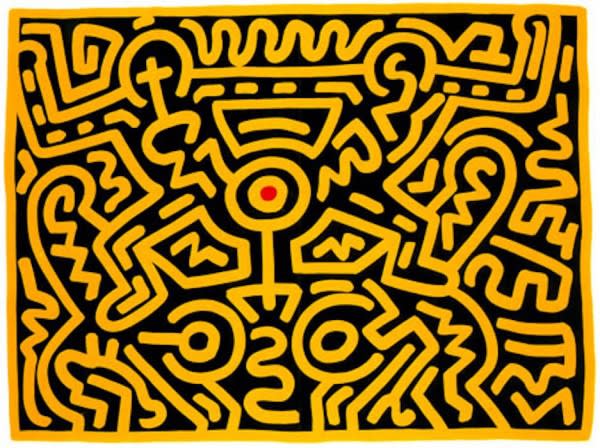After graduating from high school, Keith Haring left his family home in Kutztown, Pennsylvania, and spent just two semesters at the Ivy School of Professional Art in Pittsburgh, before dropping out and heading for New York. He was an artist. He’d been drawing from a very early age, taught by his father, who was an engineer and amateur cartoonist.
In 1978, Haring enrolled in the School of Visual Arts and began to find his path in the art world. While studying at the School of Visual Arts, he took classes in semiotics, the study of signs and symbols and their use or interpretation. He kept sketchbooks and journals, forming a language of his own, with hieroglyphs that formed his creative vocabulary.
The Signs and Symbols of Keith Haring
“One day, riding the subway, I saw this empty black panel where an advertisement was supposed to go.” Haring wrote. “I immediately realized that this was the perfect place to draw. I went back above ground to a card shop and bought a box of white chalk, went back down and did a drawing on it. It was perfect–soft black paper; chalk drew on it really easily.”
The subway drawings brought Keith Haring’s work a huge audience. He was arrested, occasionally, but said that some police officers, who gave him just a $10 fine, told him that they appreciated his work.
Keith Haring did not sign his subway drawings.
His style and symbols were unique and instantly recognizable. The crisp line drawings of simple figures, the dog, the flying saucer, the radiant baby were as clear identifiers as a signature. It was when he began showing his work at galleries that his distinguishing signature became an integral part of his artwork.
Keith Haring died in 1990, at the age of 31, but he became an international success in the last decade of his life, and left a generous legacy through the Keith Haring Foundation, which funds educational projects related to art and AIDS education.
Complete Keith Haring Signed Growing Series at Surovek Gallery
Keith Haring’s Growing series, done in 1988, is a complete set of five screenprints that celebrate life. Each screenprint in the series is framed. Done on Lenox Board, the sheet size is 30 x 40 1/8 inches. Each screenprint is signed in pencil, dated and inscribed “AP8/15’, artist’s proofs aside from the numbered edition of 100.”
Please contact us if you would like more information about the works of Keith Haring, or any of the other fine art, available at Surovek Gallery.
References:
Natty Kasambala/Ashleigh Kane. Important lessons Keith Haring taught us about life and art. DAZED. June 29, 2017.
Stephanie Strasnick. ‘Lick Boy Fat Art’: Keith Haring’s Language Art Decoded. ARTNEWS. December 17, 2013.



